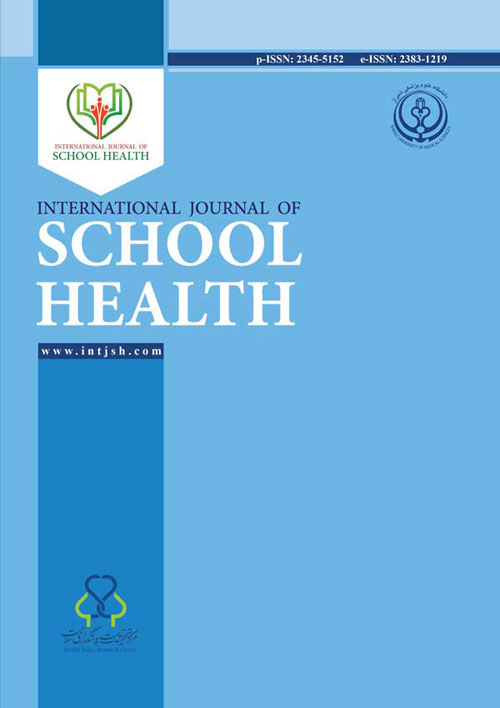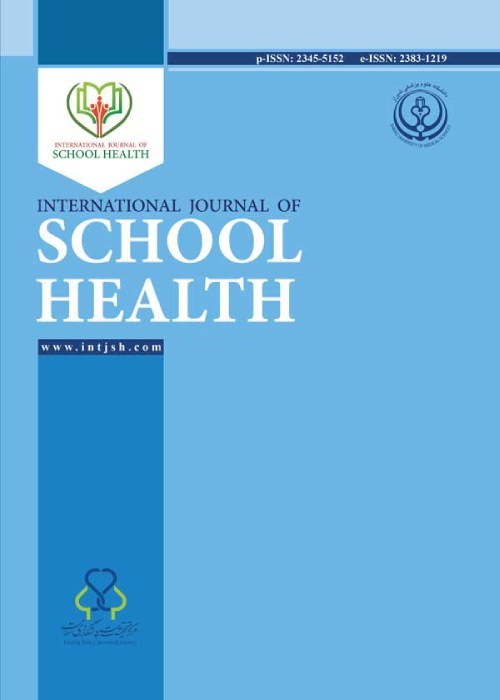فهرست مطالب

International Journal of School Health
Volume:7 Issue: 3, Summer 2020
- تاریخ انتشار: 1399/06/30
- تعداد عناوین: 8
-
-
Pages 1-5BackgroundHand washing is a believed to be a simple and effective practice to prevent communicable diseases. The infectious transmission of agents is rapid among school children due to their close relation with each other. To curtail the transmission, proper hand washing with soap is of great importance. However, in spite of its effectiveness, most of developing nations do not adhere to practices of hand washing. Since children are known as the vulnerable group who are at increased risk of communicable diseases, this study was performed to assess hand washing knowledge and practices among primary school children.The present study aims to assess the knowledge of hand-washing and its practices among primary school children and to discover the associated socio-demographic factors regarding the same issue.MethodsA community based cross-sectional study was conducted in the primary schools of Kapurthala District from October 2019 to November 2019 in order to assess the hand washing practices among the children. A total of 200 primary school children were evaluated using a self designed, self-reported and pre-tested questionnaire.ResultsStatistically significant results were found in urban population regarding hand washing before eating (P=0.006), after handling dirty things (P=0.042) and after blowing nose/coughing (P=0.024). The rural participants showed correct handwashing techniques with statistically significant P value of 0.015. Correct handwashing techniques were statistically associated with education of the children’s mothers with P value of 0.001.ConclusionRegular hand washing awareness sessions in the schools should be organized in order to keep our society safe and healthy.Keywords: Handwashing, Primary School, children
-
Pages 6-14BackgroundChildren with attention deficit hyperactivity disorder (ADHD) run a high risk of behavioral problems. Their parents are also at risk of mental health and reduced quality of life. The present study aimed to investigate the effect of group mindfulness-based stress reduction on the parents of ADHD children and their mental health, quality of life, and behavioral problems.MethodsWe conducted this single-blind randomized controlled clinical trial on 76 mothers with ADHD children aged 8-16 years referred to the clinics affiliated to Shiraz University of Medical Sciences. We randomly divided the patients into intervention and control groups. Group therapy included eight 45-minute sessions in two months and a three-month follow-up. The employed instruments were Strengths and Difficulties Questionnaire-parent form (SDQ-P), General Health Questionnaire-28 (GHQ-28), and Health related quality of life-short form-36 (HRQOL-SF-36). We analyzed all data by SPSS, and P values less than 0.05 were statistically significant.ResultsAfter the intervention, the overall mean score for GHQ-28 (P<0.01) and dimensions of HRQOL-SF-36 (P<0.01), physical (P<0.001), and mental health significantly increased (P<0.01) and SDQ-P decreased (P<0.01) in the intervention group compared to the control group.ConclusionGroup mindfulness-based stress reduction was effective on mental health and quality of life in the parents of children with ADHD and could decrease child behavioral problems.Keywords: Attention Deficit Hyperactivity Disorder, Mindfulness, Mental health, Quality of life, Behavioral problem
-
Pages 15-22Background
Internet addiction is increasingly recognized as a public health concern among children and adolescents. Its psychological and behavioural associates should be closely investigated in Nigeria. The present study aimed to report how prevalent problematic internet use is and examine its associations with psychological problems, such as depression and anxiety, and neuro-behavioural issues like drug use.
MethodsTwo public and two private schools were selected by convenience. Thereafter, a total of 420 secondary school students were randomly selected to fill a questionnaire. The data collection sheet comprised a socio-demographic section, the WHO Questionnaire for Student Drug Use Survey, Hospital Anxiety and Depression Scale, and the Internet Addiction Test. Frequency was used to determine the prevalence, while a Chi-square and an independent t-test were conducted to examine the relationship between problematic internet use and other variables.
ResultsA total of 378 questionnaires were analysed. Eighty-eight (23.3%) of the participants had scores indicating problematic internet use. While participants who had cases of anxiety (P<0.001), poor academic performance (P=0.04), used alcohol (P=0.03), and caffeine (P=0.04) over the past 30 days were associated with problematic internet use. Following a logistic regression, only students with cases of anxiety had a significant independent association with problematic internet use (AOR=1.09, 95%CI:1.02-1.16).
ConclusionsProblematic internet use is not only common among students, it also has a relationship with commonly occurring worrisome psycho-behavioural variables, requiring further research.
Keywords: Adolescent, Anxiety, Caffeine, Internet, Nigeria -
Pages 23-30BackgroundFormer studies mostly focused on the correlation of motor coordination with physical health, while this ability would be associated with mental health and certain determining performances, such as academic achievement. Hence, the purpose of this study was to investigate the relation between fine and gross motor coordination with cognitive control and academic performance.MethodsFor this purpose, we studied 87 adolescent girl students, aged 13 to 15 years old, in the first grade of high school from Qeshm Island. The Pegboard and Star excursion balance tests were utilized to assess fine and gross motor coordination and the Stroop test for cognitive control. In addition, we considered the grade point average as the academic performance. For data analysis, the correlation and regression were used.ResultsResults indicated a significant negative relation between fine motor performance with non-dominant hand and error in incongruent trials (r=-0.21, P=0.0496). Moreover, there was no direct significant relation between motor and cognitive components with academic performance. However, a significant negative relation was observed between age, academic performance (r=-0.23, P=0.03) and balance performance (r=-0.38, P=0.0001), as well as a significant direct relation between the interference score and age (r=0.21, P=0.04).ConclusionBased on the present findings, it seems that fine motor control of non-dominant hand has a common origin with inhibition. Additionally, considering the similar downward trends in the three components of academic performance, interference control, and balance as a result of the increase in age, it seems that age would be a determining factor in examining the relation between cognitive, motor, and academic performance.Keywords: Academic Performance, Executive Functions, Motor Skills
-
Pages 31-38BackgroundMothers with a blind child are more involved with the child’s behavioral problems and experience higher levels of stress and psychological crisis. The present study aimed to investigate the effects of mindful parenting skills and psychological capital on stress and psychological flexibility in mothers with blind girls.MethodsThe research method was quasi-experimental with a pre-test, post-test, and follow-up design and a control group. The sample consisted of 72 mothers with blind girl students selected by convenience sampling. We randomly divided the participants into two experimental groups (training of mindful parenting skills and psychological capital training) and a control group (n=24 per group). The research instrument included the Parental Stress Inventory and the Acceptance and Action Questionnaire.ResultsThe training intervention sessions decreased the stress levels and promoted the psychological flexibility of mothers with blind girl students in the experimental groups, compared to the control group (P=0.001). The mean±SD of the post-test scores of stress and psychological flexibility was (90.37±5.10) and (63.00±3.78) in the mindful parenting group and (104.87±4.57) and (52.37±3.32) in the psychological capital group, which was significantly different from the control groups. The group training of mindful parenting skills, in comparison to psychological capital, was more effective in reducing stress and increasing psychological flexibility among the mothers.ConclusionsThe group training of mindful parenting skills using mindfulness techniques was more effective in reducing stress and increasing the psychological flexibility.Keywords: Mindfulness, Parenting, Psychological, Stress, Pliability
-
Pages 40-45Background
Students spend a considerable amount of time at school; thus, noise pollution can have negative physical and emotional effects on them. This study aimed to determine the association between reduced noise by changing single-glazed to double-glazed windows and stress level changes among students.
MethodsWe included 384 male high school students in this study to specify the effect of noise reduction (using double-glazed windows) on classroom stress in Shiraz, 2018-2019 academic years. The participants were randomly selected from schools exposed to unauthorized noise; they were divided into control (N=192) and intervention groups (N=192). Using the Perceived Stress Scale (PSS), we assessed stress perception in a semi-experimental pretest and posttest design. Moreover, UT-353 digital sound level meter was used to measure noise pollution.
ResultsThe mean pretest and post-test scores for the intervention group were 29.30+6.878 and 24.88+8.711, respectively. The acoustic comfort induced by double-glazed windows could significantly decrease the level of stress (P<0.001). The researchers used mean statistics and standard deviation for descriptive data analysis and Independent t-test for inferential analysis. The results showed a significant difference between the intervention and control groups.
ConclusionsReplacing single-glazed windows with double-glazed ones improved the acoustic condition of the classroom, thereby reducing the stress of male high school students.
Keywords: Psychology, Noise pollution, Students, Stress, Schools -
Pages 45-54Background
The level of physical fitness indicates children’s health status and guides them towards sport branches. This crosssectional study aimed at determining the physical fitness of Cameroonian school-children aged 10 to 15 years in Yaounde city by comparing the results according to gender and with European normative values. A total of 504 healthy school children (51.58% females and 48.42% males) regularly attending physical education classes were conveniently selected from a secondary school.
MethodsWe collected anthropometric and physiological characteristics and the participants completed five physical tests integrated in the EUROFIT battery, namely standing broad jump (SBJ), flexed arm hang (FAH), sit-ups for 30 sec (SU), hand grip strength (HGS), and 10×5-m shuttle run test (10×5-mSRT). Values obtained from the tests were compared according to gender in each age.
ResultsBoys had a better performance compared with girls in different tests. No significant difference was found between boys and girls aged 10 to 14 years in 10×5-mSRT and from 10 to 12 years regarding HGS. However, performances were similar at 12 years in SBJ, at 12 and 13 years in FAH, and at 11 years in SU. School children in Yaounde city had better performances in SBJ, FAH, and 10×5-mSRT compared to their European counterparts.
ConclusionsSchool-children in Yaounde city presented high physical fitness, and males had a better physical fitness than females aged 10-15. A study including the entire EUROFIT test battery with a great number of participants is needed to provide reference values in this population
Keywords: Child, Exercise, Physical tests, Cameroon -
Pages 55-64BackgroundSchool absenteeism is a serious public health concern because of its effect on the family, society and economy of the nation at large. It is intricately linked to several social and medical conditions in which menstrual patterns and their disorders are included especially for adolescent girls. There is little evidence on the effect of menstrual disorders on school attendance in Nigeria. Therefore, this study aimed to determine the prevalence of school absenteeism due to menstrual bleeding and its associated disorders among secondary school girls in a semi-urban area of Ondo state, Southwest Nigeria.MethodA descriptive cross-sectional study was employed in eight secondary schools using a multi-stage cluster sampling technique. A self-administered questionnaire was used to obtain information on menstrual bleeding and associated disorders, school absenteeism and strategies for managing menstrual pain. Data were analysed using descriptive statistics and association between variables explored with Chi-square test at p<0.05.ResultsThe mean age of respondents was 15.6±1.6 years and the mean age at menarche was 13.2±1.3 years. School absenteeism was reported among 53.6% of the respondents and 24.7% reported absence from school due to dysmenorrhoea. School absenteeism was associated with severe menstrual pain (p=0.001), premenstrual syndrome (p=0.035) and reduced concentration in class (p=0.005). Other factors include homework performance (p=0.001) and number of daily changes of menstrual materials (p=0.046).ConclusionMenstrual disorders have been shown to have negative effects on school attendance and homework performance of the female students.Keywords: Schools, Absenteeism, Menstrual hemorrhage, Menstrual disorders, Premenstrual Syndrome


